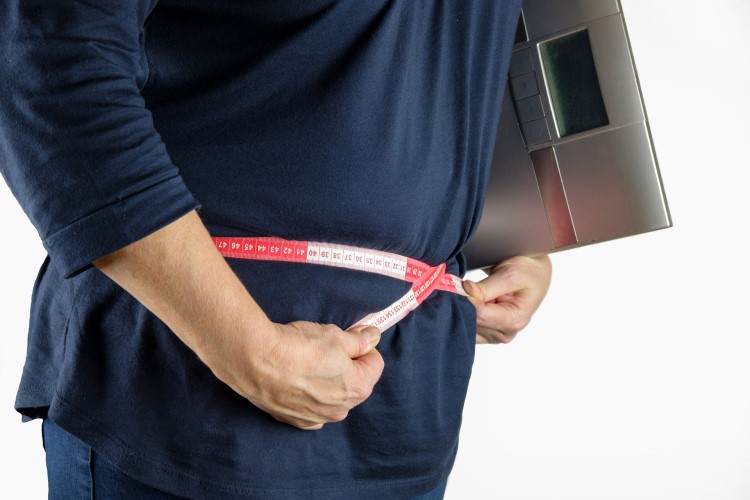
Lower back pain has many triggers. Sometimes it’s caused by trauma or lifting something heavy. More often, however, minor everyday stressors like household chores and pulling weeds are what induce pain flare-ups. In fact, science has shown the risk of lower back pain increases simply by being overweight.
Weight is a sensitive subject for many people. Nevertheless, we must address it even though doing so might be uncomfortable.
The truth is that excess weight is a physical stressor. In addition, it’s not like a heavy box you can put down or a dresser someone else can help you carry. Those extra pounds are with you 24/7.
This can cause major spinal problems under certain circumstances.
A 2010 review of 95 high-quality scientific studies concluded that the risk of lower back pain was directly related to body mass. According to the research, overweight people had a moderate risk while those who were obese had the highest risk overall. (1)
A similar conclusion was reported in 2017. A review of 1,152 subjects found that a person’s body mass directly corresponded to both the risk and rate of back problems. (2)
Many of my patients believe their back pain is the result of their spine being “out.” But it’s not that simple.
How Excess Weight Raises The Risk Of Lower Back Pain
If you never brush your teeth, you’ll eventually have a mouth full of cavities. After all, you use your teeth every day so they need ongoing care to stay healthy.
Similarly, you’re much more likely to have back problems if you don’t maintain your spine properly. You do use your spine every day too, don’t you?
Read More: Why your back keeps going out and 5 things you can do about it.
Now imagine carrying a 50 pound box in front of you everywhere you go.
Can you see why belly fat can raise the risk of lower back pain?
A 2018 study showed obesity causes an abnormal redistribution of body weight that can worsen already existing spinal problems. (3)
Added weight in the midsection shifts the pelvis forward and causes the spine to curve excessively inward. This exerts abnormal pressure on back muscles which are forced to bear the weight. (4)
Additionally, obesity accelerates arthritis of the spine. This happens because adipose tissue (fat) in the trunk creates inflammation around the areas of damage which worsens degeneration. (5)
This is not to say that all overweight people have back pain. They don’t, but these studies prove that the risk of lower back pain is greater the more weight you carry.
How Your Center Of Gravity Affects Your Risk Of Lower Back Pain
Your center of gravity is the theoretical point at which all parts of your body are in balance with each other.
When standing, the center of gravity is normally located in front of your sacrum bone at about the second sacral level. (6)
This is basically your lower back!
Read More: 7 activities to avoid when your lower back hurts.
If a part of your body leaves your center of gravity, gravitational forces begin to act on it in strange ways. Muscles, ligaments, and joints then have to adapt to keep you from falling over.
Think of it like a sack of potatoes. Gravity is acting on the sack but also on each individual potato. If enough of the potatoes shift toward one side, eventually the entire sack will topple over.
However, the human body is not a sack of potatoes. We are capable to shifting our center of gravity to keep us upright.
Unfortunately, this places added stress of our posture and spinal structures.
Authors of a 2014 study say that people with chronic lower back pain tend to have centers of gravity located excessively towards the back. The study authors concluded that people whose center of gravity is too far back could have balance challenges which lower postural control. (7)
Over time, this can raise the risk of lower back pain.
Action Steps If You Are Overweight And Have Lower Back Pain
1. As a chiropractor, the first thing I’m going to recommend is chiropractic.
Bet you didn’t see that coming!
Adjusting the spine and improving spinal function can reduce pain and make exercising easier. Otherwise, if your spine isn’t healthy, the wrong activities can make lower back pain worse.
Read More: 10 questions to ask during your chiropractic consultation.
2. Walking is a low-impact way to improve spinal health and begin losing weight.
Walking nourishes spinal joints and vertebral discs. It also strengthens important muscles in the lower back and hips.
Walk far and walk often. Just pay attention to your pain level. If walking causes pain or increases pain, take a break or stop completely.
3. Yoga will gently flex, extend, and rotate the spine and hips in healthy ways.
It’s also safer than plain stretching.
It’s important to start slow. Easy, beginner poses are all you really need.
Make sure you warm up first to avoid irritating tight spinal muscles.
Read More: 5 yoga poses for the lumbar spine.
4. As a general rule, I recommend ice for back pain rather than heat.
I know there are conflicting theories about whether you should use ice or heat for back pain. My recommendation comes from my understanding of spinal biomechanics and my own experience with patients.
Inflammation of spinal joints (rather than a “pulled” muscle) is more often at the core of lower back pain.
Ice can reduce inflammation which may diminish pain and help improve movement.
Yes, heat relaxes muscles, but it will make inflammation worse and can potentially cause more muscle tension later.
5. Make a long-term plan for losing weight.
Trying to lose too much weight too fast is the #1 reason people fail at reaching their goals.
If you have 25 pounds to lose, give yourself 6 months to do it. For 50 pounds, make it a year.
Small, imperceptible changes work best for most people.
Read More: Why 99% of people fail to keep the weight off.
*None of what you read on this website should be considered medical advice. If you make any changes to your life or health regimen because of something you read here, please do so under the guidance of a licensed health professional.



